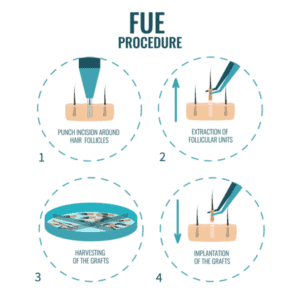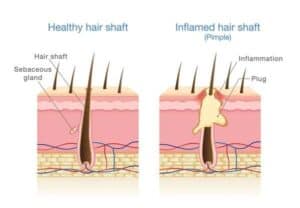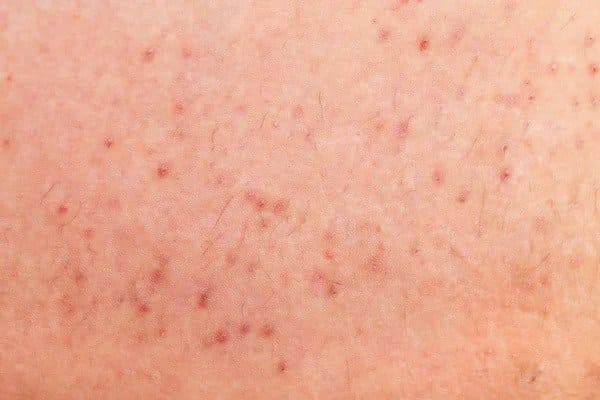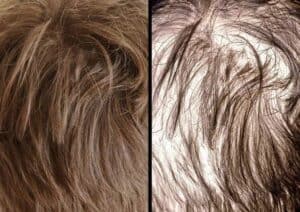Folliculitis after a hair transplant surgery can be a worrying time for any patient. If you’re worried about the inflammation of your transplanted hair follicles, then this page may have the answer! On this page you will find everything you need to know about folliculitis after hair transplants: the cause, effects, and how you can treat this condition.
Overview
Folliculitis after hair transplants is a common occurrence that affects a small number of patients. This condition is where the transplanted hair follicles become inflamed, post-surgery, requiring a course of antibiotics to treat. This infection is not life-threatening and easily treatable. In most patients, folliculitis should not affect your hair transplant result.
What is Folliculitis After a Hair Transplant?
So, you have paid for your hair transplant. You arrived on the day and one of our experienced surgeons has performed your hair transplant. You have followed your aftercare instructions to the letter but something doesn’t feel right.
You’re suffering from an itchy scalp and your transplanted hair follicles look to be a pinkish-red colour and inflamed. If this occurs, then you may be suffering from a condition called folliculitis.
Folliculitis usually occurs between two weeks and six months after a hair transplant operation. Although one or two inflamed follicles aren’t usually a huge issue, you may want to watch out if you see lots of inflammation in the same area. This may indicate that you have folliculitis after a hair transplant.
What is Folliculitis?
Folliculitis is a bacterial infection that involves the inflammation of the hair follicles. Often, folliculitis occurs after a hair transplant, particularly during the healing process. In mild cases, patients may only see red or discoloured bumps and suffer from some inflamed scalp pimples. In the worst cases, it can cause patchy regrowth in the transplanted area.
Folliculitis can be caused by various factors, including bacterial or fungal infections, irritation, or inflammation of the hair follicles. The crucial thing to do is to contact your hair transplant clinic and speak to your surgeon right away!
What Happens During a Hair Transplant?

During a DHI or FUE hair transplant, donor hair follicles are taken from the back and sides of your head and transplanted into the hairline or crown, for men, and mid-parting, for women.
During the procedure, your surgeon removes follicles using a small blade or punch tool (0.7mm to 1.00mm). The hair transplant procedure is also performed in a sterile environment in a CQC-registered clinic. Once the procedure has been completed, the donor site and recipient area are bandaged up. This helps to prevent any chance of fungal or bacterial folliculitis developing on your way home.
As a hair transplant operation does involve the movement of individual hair follicles from one area of the head to the other, this can carry a small risk of infection. Especially, when a patient returns home from their hair transplant and needs to take off their bandages.
After your hair transplant, it’s vital that you maintain a very clean scalp and wash your hair in accordance with your aftercare instructions. This will help to minimise any chance of infection and enable your new hair grafts to grow!
How Does a Hair Transplant Cause Folliculitis?
The hair transplant itself does not cause folliculitis! In fact, one study showed that folliculitis development after hair transplants only occurred in 1% of cases. However, the underlying “cause” of folliculitis is usually put down to events that occur after hair transplantation.
To put your mind at ease, a hair transplant at Harley Street Hair Transplant Clinics is performed by a GMC-registered surgeon in a CQC-compliant clinic. This means we take all the precautionary measures necessary to reduce the chances of developing scarring and infection post-surgery.
What Are the Causes of Folliculitis After Hair Transplant?
After a hair transplant, infections can develop for a number of reasons. If you’re beginning to see red or discoloured bumps or inflamed scalp skin, then it may be down to the following reasons:
- Poor hygiene and/or aftercare – your aftercare routine is, without doubt, the most important aspect of the hair transplant itself. In most cases of chronic folliculitis, it is usually down to poor hygiene after the surgery. Microbes enter open wounds, causing folliculitis after hair transplants. This is why you need to take your antibiotics and use the antibacterial shampoo provided in your aftercare package.
- Preexisting skin conditions – acne, dermatitis, and eczema are all potential causes for developing folliculitis after a hair transplant. As these are risk factors that may increase your chances of getting dermatitis after your hair transplant, we do usually recommend patients have a skin test or contact their dermatologist before they have a hair transplant.
- Badly dissected hair grafts and Poor graft placement – Although hair transplants are relatively safe procedures, it is vital that they are performed by a GMC-registered surgeon with plenty of experience. One of the causes of folliculitis after hair transplant is poor graft placement or badly dissected grafts. In both cases, this can leave the incision sites wider than needed (1.2mm to 1.5mm), leading to large scabs (excessive crust formation). As a result, this can increase the chances of folliculitis after a hair restoration surgery.
Folliculitis After Hair Transplant: Symptoms and Treatments
We’ve told you about how and why folliculitis appears after hair restoration surgeries (like follicular unit extraction and direct hair implantation). But do you know how to spot symptoms of folliculitis?
How Do I Spot Folliculitis After My Hair Transplant?
Spotting folliculitis after surgery is easy. Be sure to look out for the following symptoms:
Itchy, Hot, or Burning Skin
Inflammatory molecules in the skin can sometimes be affected if you develop folliculitis. This can cause the skin on the scalp to become inflamed, red, and itchy.
If your scalp feels hot or itchy, be sure not to itch or scratch this area. Not only can this dislodge your new hair grafts, but it can also lead to infection. Your hands are bacterial hotspots, so it is usually best to keep them well away from a healing scalp.
Instead, spray some saline solution on your scalp. This should ease your symptoms or, at the very least, reduce the need to itch and scratch.
Pimples Around the Transplanted Follicles
Small pimples on or around the transplanted area is a dead giveaway of folliculitis after a hair transplant. If pimples burst, then this can increase the chances of post-hair transplant infection.
If you begin to develop pimples after your hair transplant, then be sure to monitor this before, and after, the next time you wash your hair. If the problem persists, then you should contact your hair transplant clinic immediately.
If the pimples (red or discoloured bumps) persist, then you should contact the hair transplant clinic that has performed your hair transplant. Even if it is just a few bumps, this can affect hair growth post-surgery. So, it is always better to be safe than sorry.
Small Yellow Crusts Forming on the Affected Area
 This usually occurs during the initial recovery phase of your hair transplant. If, a few weeks after your hair transplant surgery, you still see yellowy crusts or scabs, then this may be a sign of deeper tissues being affected with folliculitis.
This usually occurs during the initial recovery phase of your hair transplant. If, a few weeks after your hair transplant surgery, you still see yellowy crusts or scabs, then this may be a sign of deeper tissues being affected with folliculitis.
In cases we have observed, of yellowing scabs, this is usually an indication of poor hygiene after a hair transplant. So, this symptom can certainly be avoided if your take your aftercare routine seriously after your FUE (follicular unit extraction) surgery.
How Do I Treat Folliculitis?
Treating folliculitis is a relatively easy process. However, hair transplant infection is much easier to “prevent” than to “cure”. So, as well as giving you the treatments, we’ll also reiterate how you can prevent the formation of folliculitis before it happens!
Following Your Aftercare Instructions!
The greatest preventative measure you can take against folliculitis is to follow your aftercare instructions. At Harley Street Hair Transplant Clinics, we have an exhaustive 14-day set of instructions for you to follow to prevent the formation of scalp pimples and red (or discolored) bumps.
This aftercare list will walk you through hair care, bandages, washing, and symptom spotting. So, make sure you follow this routine to the word!
Oral or Topical Antibiotics
If you begin to develop systemic symptoms of folliculitis, then the treatment is fairly simple. As folliculitis is usually a bacterial infection, antibiotics can usually be used to treat the condition.
Within 7-14 days, and with the help of some antibiotics, your immune system can treat and cure your folliculitis symptoms.
Will The Result of My Hair Transplant Be Ruined After Folliculitis?
The result of your hair transplant should not be affected too greatly by folliculitis. In mild cases, folliculitis should not affect your hair transplant result at all. In extreme cases, there may be a small amount of hair loss (hair follicle loss is very rare) in the transplanted area.
If you decide to leave your folliculitis untreated, then this can lead to a condition called “scarring” alopecia. This can have long-term consequences, so it is always best to get this condition checked out.
Conclusion
Folliculitis is a bacterial infection that can affect patients who have had a hair transplant. A hair transplant infection usually happens when the patient is going through a recovery period and makes itself visible in the form of scalp pimples, redness, or even ingrown hairs.
In mild cases, folliculitis is usually harmless when treated. However, in more severe cases, it can cause hair loss in the transplanted area. So, it’s vital you contact your hair transplant surgeon if you think you may be suffering from this condition.
Folliculitis is easily treatable. Patients are usually prescribed oral (systemic) antibiotics by their hair transplant surgeon. This usually clears the condition up within 7-14 days.








